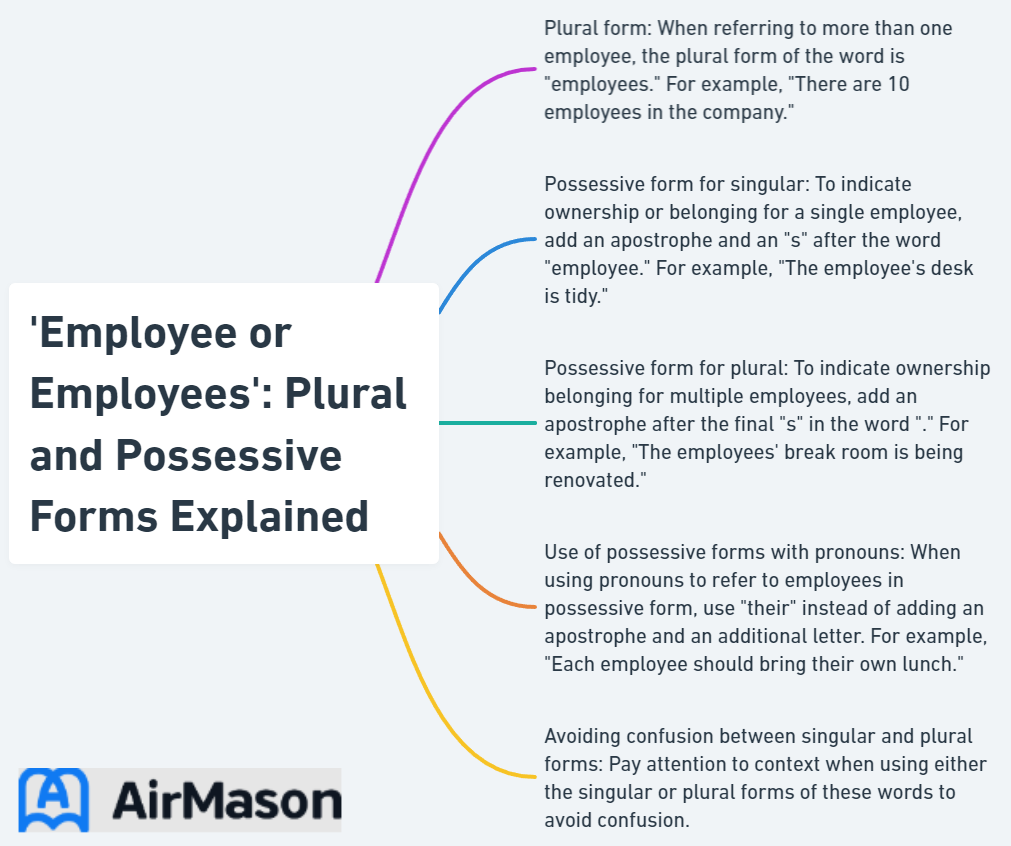
Have you ever wondered about the differences between “employee” and “employees”? It may seem trivial, but understanding the distinctions between these two terms in various contexts is essential for clear communication in the workplace. In this blog post, we will cover the different contexts of ‘employee’ or ‘employees,’ grammar rules, determiners, and even practical applications to make sure you can master the proper usage of these terms.
Key Takeaways
- Grammar rules related to the use of ‘employee’ are essential for clear communication in professional settings.
- Plural and possessive forms, apostrophe usage, and determiners should be understood when referring to one or multiple individuals employed by an organization.
- Practical applications such as employee benefits and wages can benefit from proper grammar understanding.
Employee Definition
The “employee definition” refers to the delineation of individuals within an organization who have entered into a formal agreement, either written or implied, to contribute their skills, time, and effort in exchange for compensation. This definition encompasses a broad spectrum, ranging from full-time staff to part-time workers, and it often involves specific roles and responsibilities outlined by the employer. Understanding the “employee definition” is crucial for both employers and employees, as it establishes the framework for the rights, obligations, and expectations governing the working relationship. In legal contexts, the “employee definition” may vary based on jurisdiction, industry norms, and the nature of the employment contract, highlighting the complexity inherent in categorizing individuals within the workforce.
Understanding ‘Employee’ in Different Contexts
The word “employee” can be used in multiple contexts, such as singular and plural forms. Understanding the right form to use is key to accurately conveying your intended meaning in different scenarios.Examining the singular and plural forms of ‘employee’ will give us a clearer idea of their proper application.

Singular Noun
In its simplest form, an “employee” refers to one individual who is employed by an organization and remunerated for their services. As a singular noun, ‘employee’ denotes a single person working for an employer, like in the sentence, “Mr. Smith has been with the company for a long time. He is a reliable and trusted employee. The singular noun form does not require an apostrophe, as it is not a possessive form. Synonyms for ‘employee’ as a singular noun include:- agent
- attendant
- clerk
- laborer
- member
- operator
- representative
- staff member
- hired hand
- jobholder
- hire
- worker
- Man Friday
- Understrapper
- Working Woman
- Workingman
- apparatchik
Plural Noun
When referring to multiple individuals employed by the same organization, the plural form of ‘employee’ is used – “employees”. In cases where there are more than one employee, it is important to consider their needs and preferences.- Employees chose to resign from the organization when their hours were extended.
- This demonstrates the significance of shorter working hours in the organization.
- In this context, ‘employees’ indicates a group of people working for an employer.
Plural vs. Possessive: Employee’s and Employees’

Plural Form: Employees
The plural form of “employee” is “employees”. This form is used to refer to a group of people working for an employer, as in the sentence, “The employees are diligently striving to meet the deadline”. Understanding the plural form is crucial for conveying the intended meaning in various situations. Another example of employing “employees” in a sentence is, “All the employees attended the charity drive”. In this case, “employees” refers to multiple individuals who work for the same organization and have participated in a specific event.Singular Possessive Form: Employee’s
The singular possessive form “employee’s” indicates ownership or possession by one employee. To form the singular possessive, simply append an apostrophe and an ‘s’ to the word ‘employee’. For example, consider the sentence, “The employee’s car was situated at a distance from the office”. In this case, the apostrophe denotes possession, indicating that a single employee owns the car. Another example of the singular possessive form is, “The employee’s coat was damaged when Kate’s cat got hold of it”. Here, the apostrophe is used to show possession by a single employee, emphasizing the importance of understanding the correct usage of apostrophes in possessive forms.Plural Possessive Form: Employees’
The plural possessive form “employees’” refers to something that is owned by multiple employees. To form the plural possessive, simply add an apostrophe after the ‘s’ in “employees”. For instance, consider the sentence, “The employees’ wages were reduced due to the recession”. This usage indicates that the wages of multiple employees were affected. Grasping the plural possessive form is important for clear communication as it expresses the idea of ownership or possession by multiple employees. Mastering this form will enable you to accurately convey information about groups of employees and their possessions or responsibilities.The Role of Apostrophes in Plural and Possessive Forms

Apostrophe Usage in Possessive Forms
Apostrophes are essential tools in denoting possession or ownership in possessive forms of ‘employee’. For instance, consider the sentence, “The employee’s desk is tidy”. In this case, only an apostrophe followed by an ‘s’ is used to indicate that the desk belongs to a single employee. Note that the application of apostrophes in possessive forms differs based on whether the noun is singular or plural. For singular nouns, an apostrophe followed by an ‘s’ is used, while for plural nouns, an apostrophe is placed after the ‘s’. Understanding these rules will help you avoid confusion and communicate more effectively.When Not to Use Apostrophes
A common mistake when using the word ‘employee’ is to add an apostrophe when forming the plural, which is incorrect. For example, “employee’s” should not be used to denote multiple employees; instead, the correct plural form is “employees” without an apostrophe. Keep in mind that apostrophes are not utilized to form plurals of nouns. Another common mistake is using ‘employee’s’ instead of ‘employees’’ for plurals. Apostrophes indicate possession, not plurality. Understanding this, along with the nuances of Amazon PPC, can greatly benefit from the guidance of an experienced Amazon Agentur, ensuring both your grammar and campaigns are error-free.Determiners and Their Impact on Employee Grammar
Determiners can significantly impact the grammar of ‘employee’ by providing additional clarity regarding the specified noun. This section will delve into the influence of determiners on the grammar of ‘employee’ and provide related examples.We will examine subsections 4.1 and 4.2 to understand the application of determiners with singular and plural forms, along with common determiners and examples.
How to Find Employees
In today’s competitive job market, understanding how find employees who align with your company’s values and goals is crucial. “How to find employees” is a question that many businesses grapple with as they seek to build a talented and diverse workforce. Leveraging online job boards, networking events, and social media platforms are effective strategies to connect with potential candidates. Employers can also tap into professional recruitment agencies to streamline the hiring process and identify candidates with the right skills and cultural fit. By proactively addressing the question of how to find employees, organizations can ensure they attract top talent and foster a dynamic and productive work environment.
Using Determiners with Singular and Plural Forms

- ‘the’
- ‘some’
- ‘many’
- ‘several’
Common Determiners and Examples
Determiners such as articles (a, an, the), demonstratives (this, that, these, those), quantifiers (some, any, many, few), and possessives (my, your, his, her, its, our, their) are often used with ‘employee’. For example, we can say:- ‘the employee’
- ‘an employee’
- ‘my employee’
- ‘their employee’
- ‘every employee’
- ‘few employees’
The Correct Usage of ‘All’ with ‘Employee’ or ‘Employees’

Practical Applications: Employee Benefits and Wages
Understanding the correct usage of ‘employee’ grammar has practical applications in the workplace, such as when discussing employee benefits and wages. For instance, when discussing employee benefits, the appropriate grammatical form to use is the plural form ‘benefits’. This allows for clear communication about the various advantages provided to employees by their employer.Similarly, when discussing wages, ‘employee’ should be used to refer to a single individual who is employed by a company or organization and receives compensation for their work. The plural form, ‘employees,’ should be used to refer to multiple individuals who are employed by the same company or organization and receive wages. Mastering these grammar rules will enable you to communicate effectively and accurately about employee benefits and wages in professional settings.
Grammar Rules Recap
Throughout this blog post, we have covered various grammar rules related to ‘employee,’ including plural and possessive forms, apostrophe usage, and determiners. To recap, the plural form of ‘employee’ is ‘employees,’ and the possessive forms are ‘employee’s’ for singular possession and ‘employees’’ for plural possession. Apostrophes are used to indicate possession, but not to form plurals of nouns.Determiners significantly shape the grammar of ‘employee’ by providing more clarity about the specified noun, including its plural noun ending. They can be used with singular and plural forms of ‘employee’ to convey more precise meaning in various contexts.
Mastering these grammar rules will enhance your ability to communicate clearly and precisely in professional environments.Summary
In conclusion, understanding the differences between ‘employee’ and ‘employees’ in various contexts is essential for clear communication in the workplace. By mastering the grammar rules related to plural and possessive forms, apostrophe usage, and determiners, you’ll be able to accurately convey information about employees, their possessions, and their responsibilities. Keep these rules in mind and practice applying them in your professional communication to ensure clarity and precision.
Recruiting Employees
When it comes to building a successful team, understanding and meeting recruiting employees’ expectations is crucial. The process of recruiting employees involves not only identifying qualified candidates but also creating an engaging and transparent experience for potential hires. Companies should focus on clearly communicating their values, opportunities for growth, and the overall work culture to attract the right talent. By aligning recruiting strategies with the expectations of prospective employees, organizations can foster a positive candidate experience and, ultimately, enhance their ability to secure top-tier professionals for key positions.